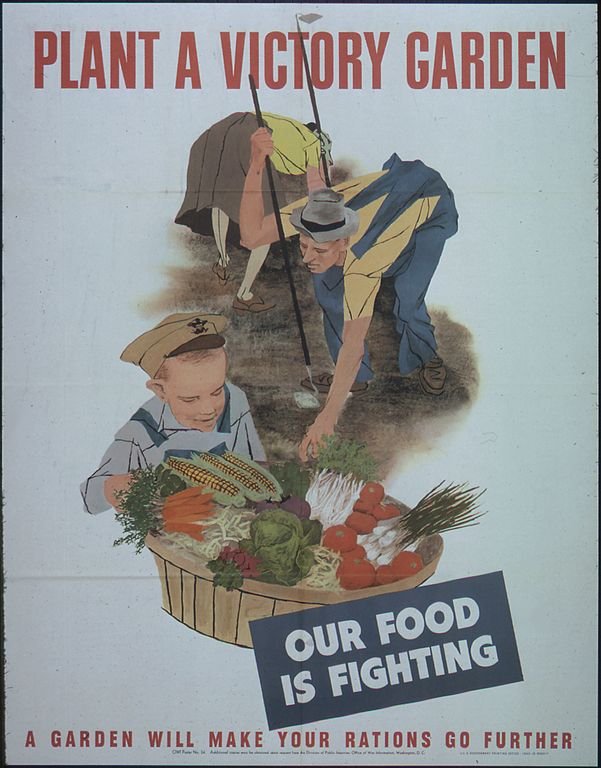As of March 2020, it doesn’t look like many people will be looking back on the year with fond memories. But it’s not the first time a country or the world has faced incredible challenges. Those were overcome, and this will be, also.
In light of the circumstances, we didn’t want to write just another “how-to” or review article. Instead, we thought it’d be better for today to look at some way that society has handled terrible challenges in the past. And one of the best ways to connect was by looking at the Victory Gardens during the world wars.
What Were Victory Gardens?
Victory gardens were planted during both World War I and World War II. Their goal was to allow families or communities to produce more of their food. This would reduce strain on large farms so that they could supply the armed forces.
Most victory gardens were grown on private land. Some, though, took over sections of public parks.
A variety of vegetables were popular. Among them were lettuce, tomatoes, peas, beans, cabbage, carrots, beets, kale, turnips, squash, onions, and Swiss chard. Herb gardens were also common. Of course, it also depended on the climate zone and regional preferences.
A yard of almost any size could accommodate at least some vegetable plants. Sometimes they were even added to rooftops. Even a window box could become a miniature victory garden!
Want to plants flowers? Learn when to get started!
How Did Victory Gardens Get Started?
During times of war, there is an increased demand for resources. Materials that were normally used for regular consumer use end up diverted to military use. That includes metals, rubber, and other raw products. But soldiers need to be fed, too, so the food supply is also diverted.
That need, of course, often leads to the rationing of food. But a new idea arose during the First World War, too: victory gardens. The American scientist George Washington Carver – yes, the same man who thought up so many uses for peanuts – wrote about the idea early on. He appears to be the originator of the idea.
Victory gardens weren’t only common in America, or even among the allied countries. In addition to the USA, they were also common in Australia, the United Kingdom, Canada, and Germany. In Britain, they were popularized as “digging for victory.”

After World War I, many people continued their gardens. When World War II began, though, new emphasis was put on them. In the US, millions of flyers were distributed to encourage people to make their contribution to the war effort in this way.
These efforts weren’t left for just the “common folk.” First Lady Eleanor Roosevelt even had a Victory Garden planted on the White House lawn!
Were They Effective?
It’s hard to measure the effectiveness of Victory Gardens. It’s also hard to judge what the real goal of them was.
The idea took off. For instance, by the middle of World War II, there were 18 million victory gardens in the US. Two-thirds of them were in cities. By 1944, victory gardens produced as much produce as commercial farms. That’s a lot of fruit and veggies!
But beyond the actual food, there was a motivational purpose behind these gardens. They helped to unite people behind the war efforts. The public understood that they were contributing, even if indirectly, to the support of the country. That was true, of course, but it was also a psychological factor in helping to maintain support.
I’d have to say that the victory gardens were indeed a success on both fronts. They helped families be more self-sustaining. They were an economic aid to these families during wartime and as the world came out of the Great Depression. And they did become a way to enhance patriotism during devastating wars.
How You Can Plant a Victory Garden
You can have a victory garden and enjoy the fruits of your labor. Even with a small yard – or a window box, as we mentioned above – you can grow at least some vegetables on your own. Many home improvement stores remain open as essential services during social distancing measures. That means it’s still possible to get the materials you’ll need as well.
You can start your garden indoors. Fill some paper cups with soil and plant seeds in them. Covering them with plastic will keep the soil moist.
Once seedlings plant, it’s time to move them to a more permanent home. This can be a plot of land, a flower pot large enough for them to grow, or a window box.
Be sure to choose a spot that gets 7 or 8 hours of sunlight per day; most vegetables need that.
For outdoor planting, you’ll just need a few tools:
- A garden shovel
- A hoe (if you’re seeding directly outdoors)
- A trowel or dibber (if you’re transplanting seedlings or working in a pot or window bed)
- Bagged compost (or make your own compost)
- Watering can
- Seeds
If you have an outdoor plot, turn over the soil and break it up thoroughly. It’s best to turn it over to about 6 inches deep.
Use your hoe to create furrows in the plot. If you’re planting seeds directly in the soil, spread them along the furrows.
Spread compost about an inch thick across the garden area. This will help make sure there are enough nutrients in the soil for your plants to prosper.
If you’re transplanting, you may not need to create furrows. However, they can help keep your plants in straight lines. This can help create proper spaces and keep different vegetables separate as they start to grow. Use your trowel or a dibber to create a small hole to plant the seedlings.
Some vegetables, like green onions, bok choy, lettuce, radishes, and arugula can be ready in as little as a month. Others may take longer but it will be worth the wait!
Conclusion
If you want to try your hand at vegetable gardening, even on a small scale, a victory garden is a great choice. It’s not only for moments of crisis, either, although it is a great way to pass the time and overcome boredom. Homegrown vegetables taste great and provide a fantastic sense of accomplishment, too!









